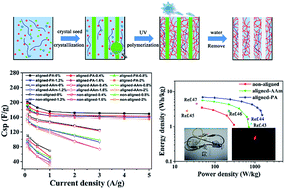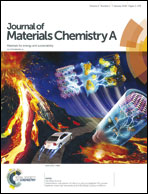Polyampholyte-doped aligned polymer hydrogels as anisotropic electrolytes for ultrahigh-capacity supercapacitors†
Abstract
Pressure-resistant polymer gel electrolytes with convenient ion channels are a key challenge for wearable energy devices to improve their safety and reliability. Our biomimetic aligned hierarchical design and facile polyampholyte doping of the polymer hydrogels are utilized to simultaneously achieve high strength and large ionic mobility, despite the fact that these two factors of traditional polymer gels are mutually restricted by the Flory–Rehner equation. The viscosity-dependent hot-ice templates endow the polymer hydrogels with large aligned pores that are adjustable from 19 to 68 μm, which can benefit their ion mobility and capacity due to the shortened ion migration distance within the electrolytes. The further copolymerization of the polyampholyte component within the hydrogel network can further enhance the capacity due to the increased adhesion between the hydrogel electrolytes and the charged carbon electrode materials. The optimized supercapacitor capacity of the aligned gel electrolytes was 201.5 F g−1 at a 0.1 A g−1 current density in the vertical direction, larger than that of a liquid electrolyte of 159.0 F g−1. Our hybrid polymer hydrogel has demonstrated high electrochemical performance due to the aligned structure and charging-adjusted adhesion by the polyampholyte.



 Please wait while we load your content...
Please wait while we load your content...